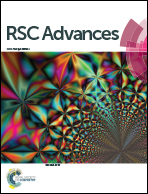Enhanced visible-light photocatalytic performance of BiOBr/UiO-66(Zr) composite for dye degradation with the assistance of UiO-66†
Abstract
Because of their many outstanding properties, metal–organic frameworks (MOFs) are considered as a suitable material for various applications in the area of catalysis. Specifically, the superior stability of UiO-66, a zirconium based MOF, makes it a more competitive candidate for the development of a catalyst used in water treatment. In this study, a series of BiOBr/UiO-66 composites with different BiOBr contents were prepared by incorporating UiO-66 with BiOBr through a convenient solution method. In the rhodamine B (RhB) degradation experiment, the resulting BiOBr/UiO-66 composite not only exhibited enhanced photocatalytic activity compared to the control experiment where the mixture of pristine BiOBr and UiO66 was used, but also demonstrated good stability and reusability which was verified by different characterization techniques. The good interaction between UiO-66 and BiOBr was expected to play a crucial role in achieving the excellent properties of the BiOBr/UiO-66 composite. Furthermore, by introducing different scavengers to compete with the potential active species involved in the degradation process, the photocatalytic mechanism of RhB degradation by the BiOBr/UiO-66 composite was investigated.


 Please wait while we load your content...
Please wait while we load your content...